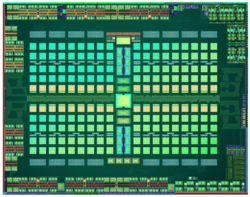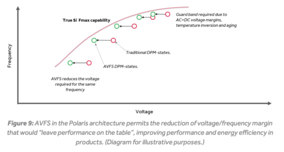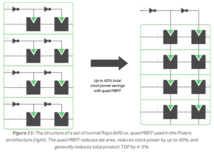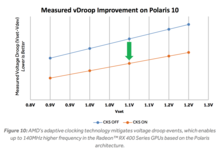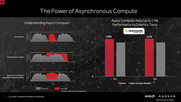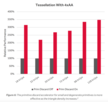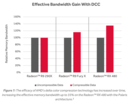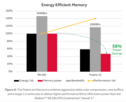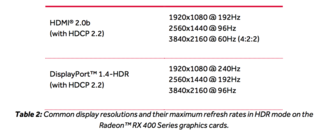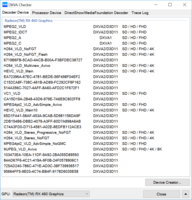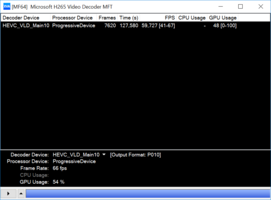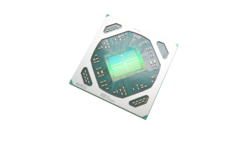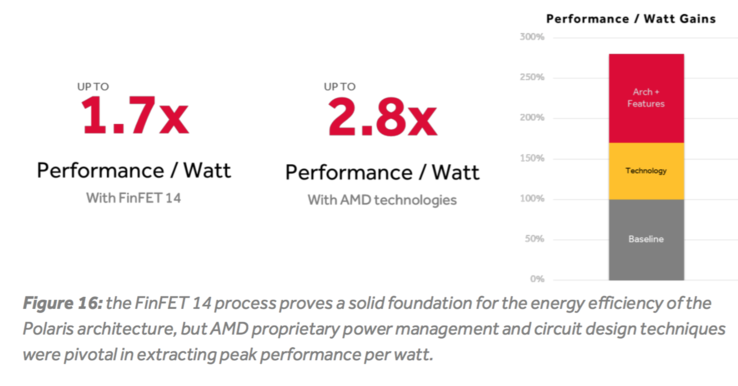AMD's Polaris Architecture
For the original German article, see here.
The Polaris architecture is used in two chips, the smaller Polaris 11 with 16 CUs (Compute Units) and the Polaris 10 with 36 Compute Units (CUs). Both of them are used in many models for desktop PCs and notebooks and differ by the number of activated CUs, clock rates, and memory implementation. However, the features are the same regardless of the product (no artificial limitation). Polaris-based products can be recognized by an RX in front of a 4xx number in their name.
14 nm process
The Polaris chips are produced in the new 14 nm FinFET process (3D transistors) at GlobalFoundries and are a significant step forward from the predecessor generation, which was produced in 28 nm process. In addition to the smaller lithography, it brings several technical innovations:
- Adaptive Clocking - energy saving potential of up to 25% in certain scenarios.
- Adaptive Voltage & Frequency Scaling (AVFS) - just as in the latest Bristol Ridge APUs, this ensures an optimal power supply in every end product.
- Boot Time Power Supply Calibration (BTC) - known from APUs; calibrates the chip to the power supply.
- Adaptive Aging Compensation - known from APUs; finer adaption to aging makes for lower tolerances.
GCN 4
Polaris integrates the fourth generation of the Graphics Architecture Next (also called GCN 4), which brings many improvements and optimizations compared to the predecessor generation. AMD primarily mentions the following improvements:
- Geometry engine.
- Shader efficiency - up to 15% per CU (RX 480 vs. R9 290).
- Color compression - Delta Color Compression (DCC) allows up to 30% higher bandwidth with compressible data (predecessor: only 18%).
- Async Compute.
- Bigger L2 Cache - is supposed to make higher energy efficiency possible and supports DCC.
- Optimized memory controller.
- Liquid VR Support - for example Variable Rate Shading: only renders the focal point with high resolution by means of the Multi Viewport Engine.
- TrueAudio Next; Ray Tracing Audio and Asynchronous Compute use without dedicated hardware.
Display-Outs
Just like the Pascal architecture, Polaris also supports the latest (and coming standards) for video output. DisplayPort 1.4 (ready) and HDMI 2.0b support high-resolution displays. AMD for example mentions 5K60 with a single cable and 4K120 with FreeSync (both via DisplayPort). HDR displays are supported with 10-Bit 4K96.
Video Engine
Several improvements have been made to the video engine. Primarily, the support for HEVC/H.265 has been improved (e.g. HEVC Main-10 4K60). According to AMD, the chips feature hardware-support of the following codecs for decoding:
- HEVC 4K60 Main-10
- VP9 4K
- MJPEG 4K30
- H.264 4K120
- MP4-P2 1080p60
- VC1 1080p60
- Netflix and Amazon 10-bit HEVC
- Twitch H.264
- YouTube VP9
- Skype HEVC & MJPEG
The two chips Polaris 10 and Polaris 11
Polaris 10
Polaris 10 is the bigger chip and was initially used in the AMD Radeon RX 480 and RX 470 desktop graphics cards. The chip features 36 Compute Unites (CUs) = 2304 shaders, 4 geometry processors, 144 texture units, 2 MB L2 cache and a 256-bit GDDR5 memory interface (for up to 8 GB).
Polaris 11
The smaller Polaris 11 chip features 16 CUs = 1024 shaders, 1 MB L2 cache and a 128-bit GDDR5 memory bus. In addition to the features of the Polaris 10 chip, Polaris 11 provides Power Gating between CUs, which makes it significantly more efficient under partial load. As a result, it is also more frugal without load. Initially, it is used in a desktop chip called AMD Radeon RX 460 with only 14 CUs. In contrast, the mobile RX 460 (called RX 480M previously) provides all 16 CUs (at reduced clock rates).
Efficiency
The efficiency of the Polaris chips cannot entirely keep up with the more expensive Pascal models (e.g. GTX 1060). In view of the lower price target, there might still be potential for improvement of the board design.
Without load, especially Polaris 11 in the RX 470 and RX 480 is disappointing in this aspect at launch time. Under load, both products prove to be significantly more efficient than the predecessor generation.
Summary
The Polaris chips are the first products from AMD in the new 14 nm FinFET process. However, they are not only a die shrink, but they also bring several changes on architecture level. While Polaris and Pascal appear to be on par on feature level, the efficiency of the first Pascal cards is slightly better. However, Pascal does not target at the cheap entry-level range, where price is an important factor.




